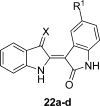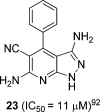Recent advances in the design, synthesis, and biological evaluation of selective DYRK1A inhibitors: a new avenue for a disease modifying treatment of Alzheimer's?
- PMID: 23173067
- PMCID: PMC3503344
- DOI: 10.1021/cn300094k
Recent advances in the design, synthesis, and biological evaluation of selective DYRK1A inhibitors: a new avenue for a disease modifying treatment of Alzheimer's?
Abstract
With 24.3 million people affected in 2005 and an estimated rise to 42.3 million in 2020, dementia is currently a leading unmet medical need and costly burden on public health. Seventy percent of these cases have been attributed to Alzheimer's disease (AD), a neurodegenerative pathology whose most evident symptom is a progressive decline in cognitive functions. Dual specificity tyrosine phosphorylation regulated kinase-1A (DYRK1A) is important in neuronal development and plays a variety of functional roles within the adult central nervous system. The DYRK1A gene is located within the Down syndrome critical region (DSCR) on human chromosome 21 and current research suggests that overexpression of DYRK1A may be a significant factor leading to cognitive deficits in people with Alzheimer's disease (AD) and Down syndrome (DS). Currently, treatment options for cognitive deficiencies associated with Down syndrome, as well as Alzheimer's disease, are extremely limited and represent a major unmet therapeutic need. Small molecule inhibition of DYRK1A activity in the brain may provide an avenue for pharmaceutical intervention of mental impairment associated with AD and other neurodegenerative diseases. We herein review the current state of the art in the development of DYRK1A inhibitors.
Figures
















References
-
- Becker W.; Joost H. G. (1999) Structural and Functional Characteristics of DYRK, a Novel Family of Protein Kinases with Dual Specificity. Prog. Nucleic Acid Res. 62, 1–17. - PubMed
- Becker W.; Sippl W. (2011) Activation, Regulation, and Inhibition of DYRK-1A. FEBS J. 278, 246–256. - PubMed
- Aranda S.; Laguna A.; de la Luna S. (2011) DYRK Family of Protein Kinases: Evolutionary Relationships, Biochemical Properties, and Functional Roles. FASEB J. 25, 449–462. - PubMed
-
- Tejedor F. J.; Hämmerle B. (2010) MNB/DYRK1A as a Multiple Regulator of Neuronal Development. FEBS J. 278, 223–235. - PubMed
-
- Park J.; Song W. J.; Chung K. C. (2009) Function and Regulation of DYRK1A: Towards Understanding Down Syndrome. Cell. Mol. Life Sci. 66, 3235–3240. - PMC - PubMed
- Martí E.; Altafaj X.; Dierssen M.; de la Luna S.; Fotaki V.; Alvarez M.; Pérez-Riba M.; Ferrer I.; Estivill X. (2003) Dyrk1A Expression Pattern Supports Specific Roles of this Kinase in the Adult Central Nervous System. Brain Res. 964, 250–263. - PubMed
-
- Fotaki V.; Martínez De Lagrán M.; Estivill X.; Arbonés M.; Dierssen M. (2004) Haploinsufficiency of DYRK1A in Mice Leads to Specific Alterations in the Development and Regulation of Motor Activity. Behav. Neurosci. 118, 815–821. - PubMed
Publication types
MeSH terms
Substances
Grants and funding
LinkOut - more resources
Full Text Sources
Other Literature Sources
Medical

